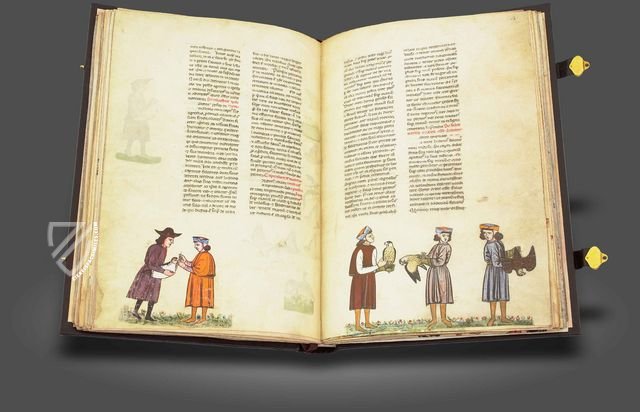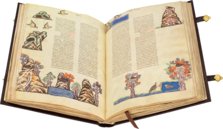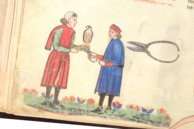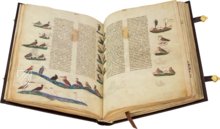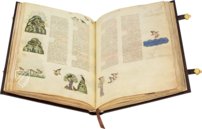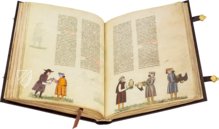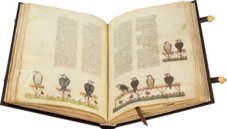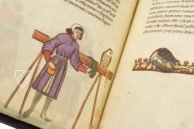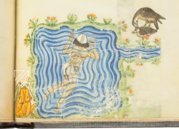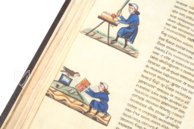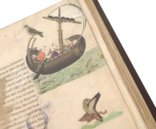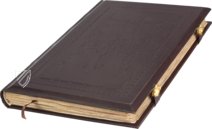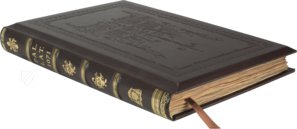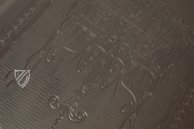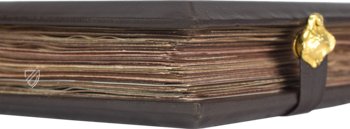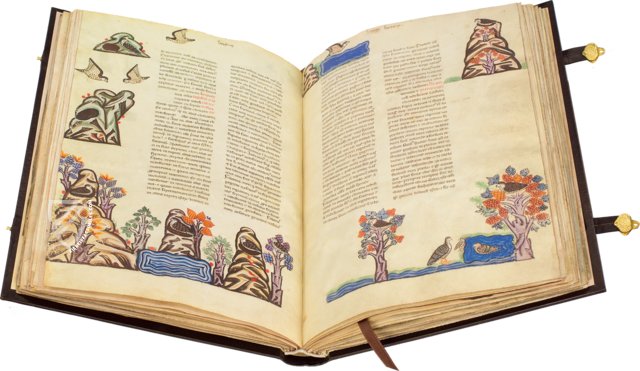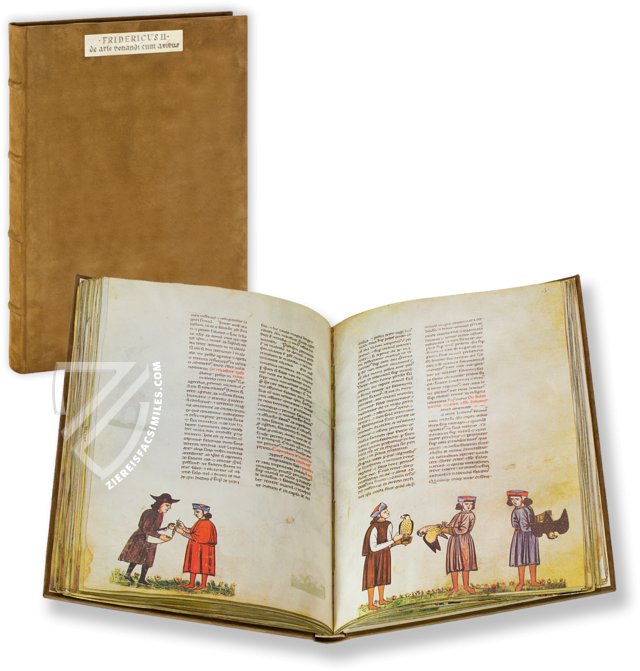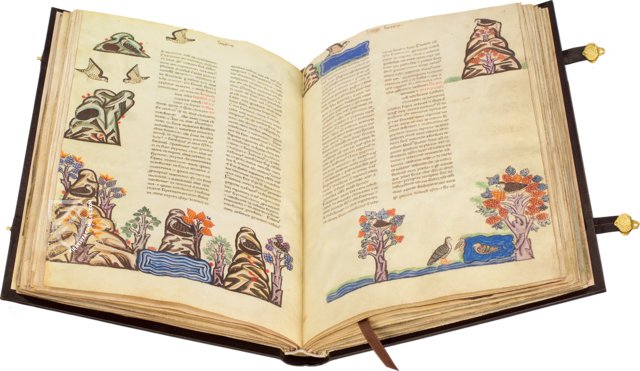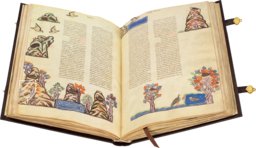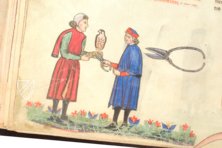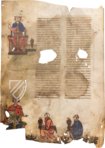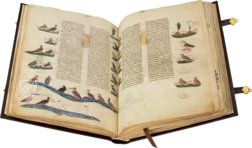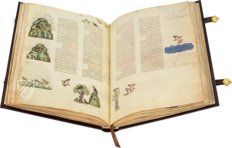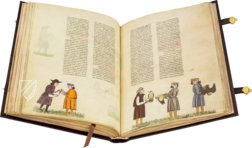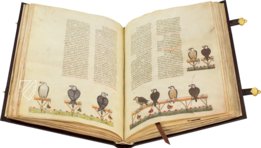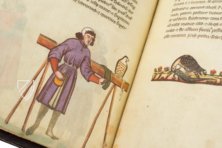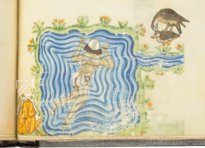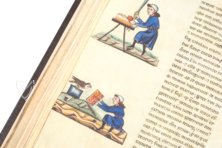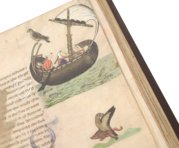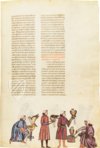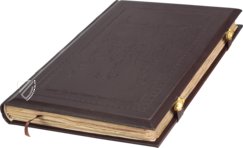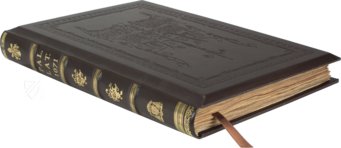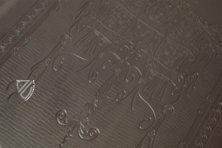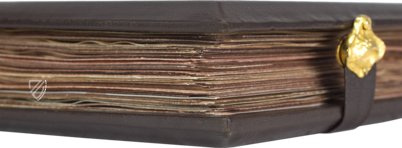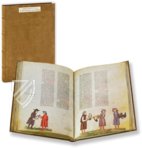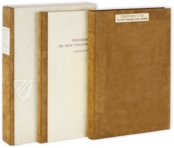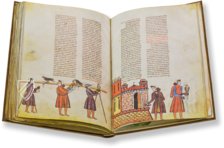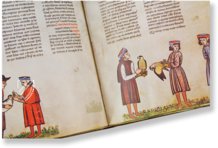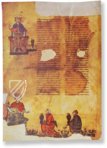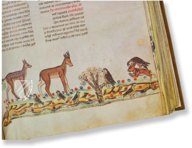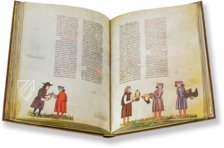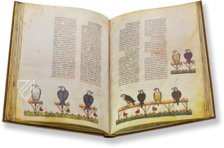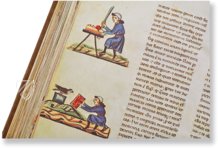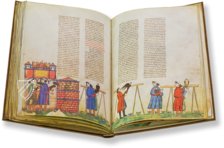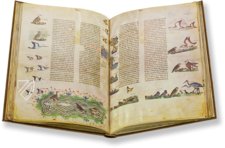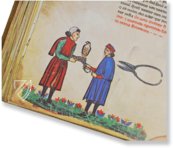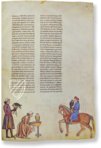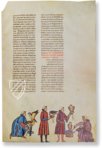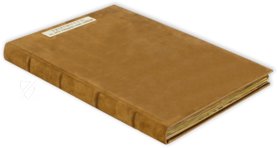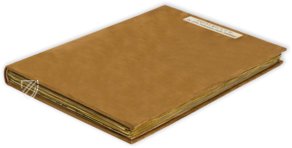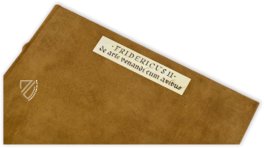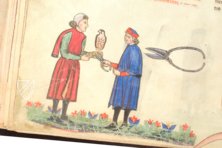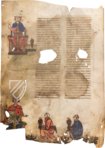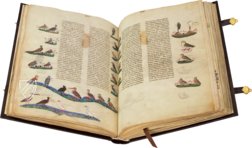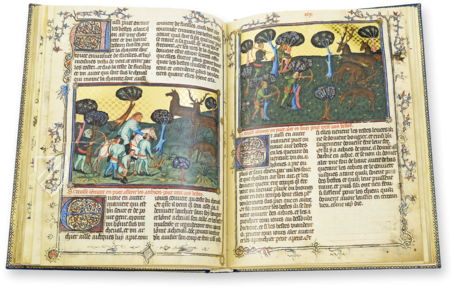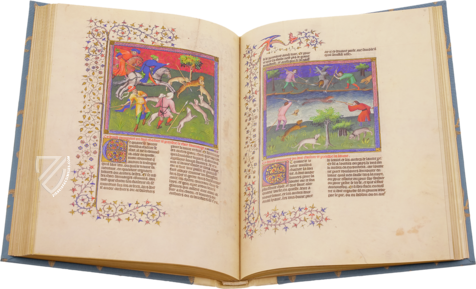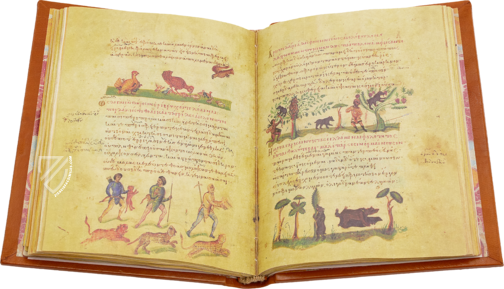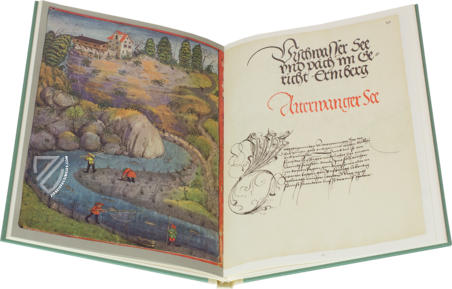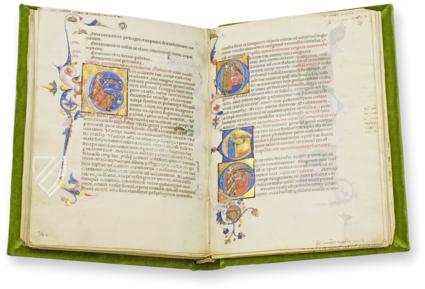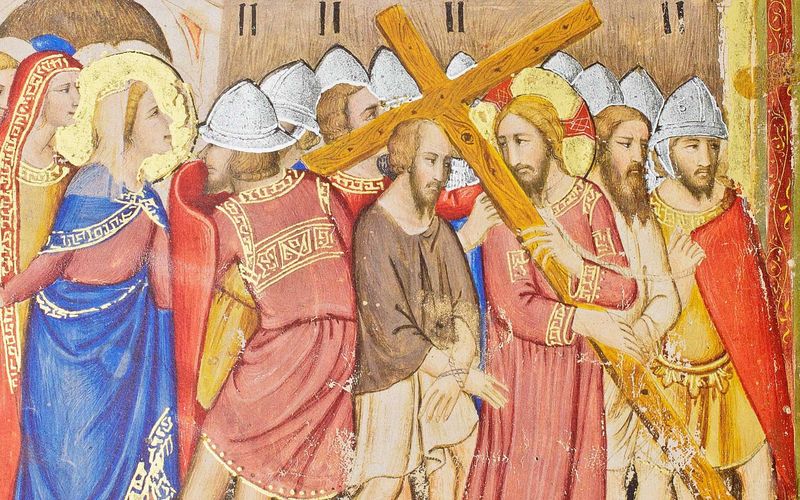The Art of Falconry by Frederick II
(3,000€ - 7,000€)
The Falcon Book of Emperor Frederick II originates from Italy from somewhere between 1258 and 1266. It was composed by the enthusiastic falconer Frederick from Arabic sources and his own experiments and observations. The special manuscript remained into modern times a standard work of ornithology and impressed its readers with unbelievably realistic and precise scenes from nature.
Emperor Frederick II’s Falcon Book
One of the most important textbooks about falconry and ornithology of the Middle Ages was composed by Emperor Frederick II. The manuscript with the Latin title De arte vanandi cum avibus was written by Frederick II with comments from his son Manfred between 1241 and 1248. One hundred and seventy depictions of human figures illustrate the work. Additionally the book includes pictures from more than 900 types of bird, of twelve horses and thirty-six other animals as well as equipment that is necessary for falconry.
The Historical Background
Fredrick II of the noble Staufer family was the King of Sicily from 1198, the Roman-German King from 1212 and Emperor from 1220 until his death. He was one of the greatest rulers of the Middle Ages. His court developed as an important center of literature and science. The keen ornithologist composed his Falcon Bookusing Arabic sources and his own observations. The text is illustrated with more than nine hundred pictures of over eighty different types of bird. They show the different attitudes of the birds but falconers, their activities, and their tools are also depicted. It also provides information on the operation of a falconry.
Attractive Book Decoration
The Falcon Book has remained the standard work of falconryuntil well into modern times. This is due in particular to the scientific accuracy and systematic approach of Frederick, who worked with empirical methods and was thus far ahead of his contemporaries. Several experiments on his study of admired birds make his work unique, but his wonderful illustrations also contribute to the extraordinary fame of the book. The fully illuminated manuscript shows images of unsurpassed closeness to nature and precision. Though landscape and architectural scenery is consistent with contemporary style, the inclusion of over nine hundred pictures of birds is a novelty. A previously unknown realism is achieved in the pictures – from the appearance to the specific attitudes of the various bird types. The original issue of the Falcon Book can be found today in the apostolic library in the Vatican.
Codicology
- Alternative Titles
- De Arte Venandi cum avibus
Arte de cetrería de Federico II
Falkenbuch Friedrichs II.
Die Kunst mit Falken zu Jagen von Kaiser Friedrich II.
Falkenbuch Kaiser Friedrichs II. - De arte venandi cum avibus
Emperor Frederick II – The Art of Falconry
Manfred Manuscript
Über die Kunst mit Vögeln zu jagen - Size / Format
- 222 pages / 36.0 × 25.0 cm
- Origin
- Italy
- Date
- Ca. 1258–1266
- Epochs
- Style
- Genre
- Language
- Illustrations
- 170 human figures, more than 900 species of birds, 12 horses and 36 other animals plus all the paraphenalia needed for falconry
- Content
- Treatise on hunting with birds of prey and a study of birds
- Patron
- Emperor Frederick II von Hohenstaufen (1194–1250) and his son Manfred, King of Sicily (1232–66)
- Artist / School
- Frederick II von Hohenstaufen (1194–1250) (author)
- Previous Owners
- Jean II de Dampierre (1255–1307)
Joachim Camerarius the Younger (1534–98)
Ludwig Camerarius (1573–1651)
Palatinate Library of Heidelberg
The Art of Falconry by Frederick II
The Emperor’s Falconers
A team of falconers was required to maintain the unequalled collection of falcons and hawks belonging to the greatest falconer in history, Holy Roman Emperor Frederick II von Hohenstaufen. They are dressed in the flowing robes popular in the 13th century, with the striped clothing of the two central figures indicating that they are wealthy, perhaps even noble. Two more modestly-dressed falconers kneel on either side of them, one tying his bird to a perch, while the other’s bird bathes itself.
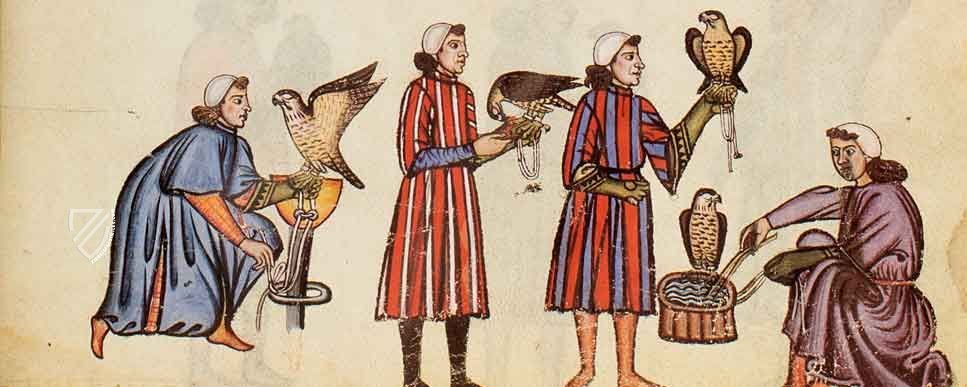
The Art of Falconry by Frederick II
Author Page
The second page of this manuscript is damaged, but contains an important portrait of its author, the powerful and brilliant Holy Roman Emperor Frederick II. He is depicted enthroned, crowned, and wearing a blue cloak and red tunic, holding a fleur-de-lys in his right hand, pointing to his falcon with the left. His son, King Manfred of Sicily, is depicted below him in almost identical fashion, but he is holding a scepter and the colors of their garments are switched.
Normally, one might expect a dedication miniature on a page in this part of a codex, wherein a scribe or monk would present a book to the patron. Instead we have a depiction of Frederick and his son being presented with hooded falcons by kneeling, well-dressed falconers.
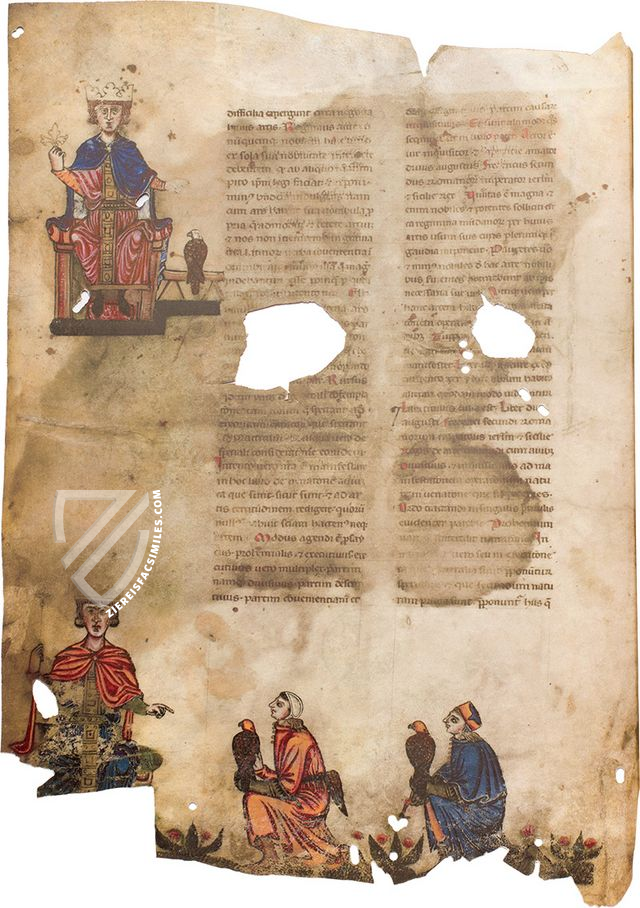
#1 Arte de Cetrería de Federico II
Language: Spanish
(3,000€ - 7,000€)
#2 De Arte Venandi cum Avibus
Language: German
(1,000€ - 3,000€)
#3 De Arte Venandi cum Avibus
(1,000€ - 3,000€)
- Treatises / Secular Books
- Apocalypses / Beatus
- Astronomy / Astrology
- Bestiaries
- Bibles / Gospels
- Chronicles / History / Law
- Geography / Maps
- Saints' Lives
- Islam / Oriental
- Judaism / Hebrew
- Single Leaf Collections
- Leonardo da Vinci
- Literature / Poetry
- Liturgical Manuscripts
- Medicine / Botany / Alchemy
- Music
- Mythology / Prophecies
- Psalters
- Other Religious Books
- Games / Hunting
- Private Devotion Books
- Other Genres
- Afghanistan
- Armenia
- Austria
- Belgium
- Belize
- Bosnia and Herzegovina
- China
- Colombia
- Costa Rica
- Croatia
- Cyprus
- Czech Republic
- Denmark
- Egypt
- El Salvador
- Ethiopia
- France
- Germany
- Greece
- Guatemala
- Honduras
- Hungary
- India
- Iran
- Iraq
- Israel
- Italy
- Japan
- Jordan
- Kazakhstan
- Kyrgyzstan
- Lebanon
- Liechtenstein
- Luxembourg
- Mexico
- Morocco
- Netherlands
- Palestine
- Panama
- Peru
- Poland
- Portugal
- Romania
- Russia
- Serbia
- Spain
- Sri Lanka
- Sweden
- Switzerland
- Syria
- Tajikistan
- Turkey
- Turkmenistan
- Ukraine
- United Kingdom
- United States
- Uzbekistan
- Vatican City
- A. Oosthoek, van Holkema & Warendorf
- Aboca Museum
- Ajuntament de Valencia
- Akademie Verlag
- Akademische Druck- u. Verlagsanstalt (ADEVA)
- Aldo Ausilio Editore - Bottega d’Erasmo
- Alecto Historical Editions
- Alkuin Verlag
- Almqvist & Wiksell
- Amilcare Pizzi
- Andreas & Andreas Verlagsbuchhandlung
- Archa 90
- Archiv Verlag
- Archivi Edizioni
- Arnold Verlag
- ARS
- Ars Magna
- ArtCodex
- AyN Ediciones
- Azimuth Editions
- Badenia Verlag
- Bärenreiter-Verlag
- Belser Verlag
- Belser Verlag / WK Wertkontor
- Benziger Verlag
- Bernardinum Wydawnictwo
- BiblioGemma
- Biblioteca Apostolica Vaticana (Vaticanstadt, Vaticanstadt)
- Bibliotheca Palatina Faksimile Verlag
- Bibliotheca Rara
- Boydell & Brewer
- Bramante Edizioni
- Bredius Genootschap
- Brepols Publishers
- British Library
- C. Weckesser
- Caixa Catalunya
- Canesi
- CAPSA, Ars Scriptoria
- Caratzas Brothers, Publishers
- Carus Verlag
- Casamassima Libri
- Centrum Cartographie Verlag GmbH
- Chavane Verlag
- Christian Brandstätter Verlag
- Circulo Cientifico
- Club Bibliófilo Versol
- Club du Livre
- CM Editores
- Collegium Graphicum
- Collezione Apocrifa Da Vinci
- Comissão Nacional para as Comemorações dos Descobrimentos Portugueses
- Coron Verlag
- Corvina
- CTHS
- D. S. Brewer
- Damon
- De Agostini/UTET
- De Nederlandsche Boekhandel
- De Schutter
- Deuschle & Stemmle
- Deutscher Verlag für Kunstwissenschaft
- DIAMM
- Droz
- E. Schreiber Graphische Kunstanstalten
- Ediciones Boreal
- Ediciones Grial
- Ediclube
- Edições Inapa
- Edilan
- Editalia
- Edition Deuschle
- Edition Georg Popp
- Edition Leipzig
- Edition Libri Illustri
- Editiones Reales Sitios S. L.
- Éditions de l'Oiseau Lyre
- Editions Medicina Rara
- Editorial Casariego
- Editorial Mintzoa
- Editrice Antenore
- Editrice Velar
- Edizioni Edison
- Egeria, S.L.
- Eikon Editores
- Electa
- Emery Walker Limited
- Enciclopèdia Catalana
- Eos-Verlag
- Ephesus Publishing
- Ernst Battenberg
- Eugrammia Press
- Extraordinary Editions
- Fackelverlag
- Facsimila Art & Edition
- Facsimile Editions Ltd.
- Facsimilia Art & Edition Ebert KG
- Faksimile Verlag
- Feuermann Verlag
- Folger Shakespeare Library
- Franco Cosimo Panini Editore
- Friedrich Wittig Verlag
- Fundación Hullera Vasco-Leonesa
- G. Braziller
- Gabriele Mazzotta Editore
- Gebr. Mann Verlag
- Gesellschaft für graphische Industrie
- Getty Research Institute
- Giovanni Domenico de Rossi
- Giunti Editore
- Graffiti
- Grafica European Center of Fine Arts
- Guido Pressler
- Guillermo Blazquez
- Gustav Kiepenheuer
- H. N. Abrams
- Harrassowitz
- Harvard University Press
- Helikon
- Hendrickson Publishers
- Henning Oppermann
- Herder Verlag
- Hes & De Graaf Publishers
- Hoepli
- Holbein-Verlag
- Houghton Library
- Hugo Schmidt Verlag
- Idion Verlag
- Il Bulino, edizioni d'arte
- ILte
- Imago
- Insel Verlag
- Insel-Verlag Anton Kippenberger
- Instituto de Estudios Altoaragoneses
- Instituto Nacional de Antropología e Historia
- Introligatornia Budnik Jerzy
- Istituto dell'Enciclopedia Italiana - Treccani
- Istituto Ellenico di Studi Bizantini e Postbizantini
- Istituto Geografico De Agostini
- Istituto Poligrafico e Zecca dello Stato
- Italarte Art Establishments
- Jan Thorbecke Verlag
- Johnson Reprint Corporation
- Josef Stocker
- Josef Stocker-Schmid
- Jugoslavija
- Karl W. Hiersemann
- Kasper Straube
- Kaydeda Ediciones
- Kindler Verlag / Coron Verlag
- Kodansha International Ltd.
- Konrad Kölbl Verlag
- Kurt Wolff Verlag
- La Liberia dello Stato
- La Linea Editrice
- La Meta Editore
- Lambert Schneider
- Landeskreditbank Baden-Württemberg
- Leo S. Olschki
- Les Incunables
- Liber Artis
- Library of Congress
- Libreria Musicale Italiana
- Lichtdruck
- Lito Immagine Editore
- Lumen Artis
- Lund Humphries
- M. Moleiro Editor
- Maison des Sciences de l'homme et de la société de Poitiers
- Manuscriptum
- Martinus Nijhoff
- Maruzen-Yushodo Co. Ltd.
- MASA
- Massada Publishers
- McGraw-Hill
- Metropolitan Museum of Art
- Militos
- Millennium Liber
- Müller & Schindler
- Nahar - Stavit
- Nahar and Steimatzky
- National Library of Wales
- Neri Pozza
- Nova Charta
- Oceanum Verlag
- Odeon
- Orbis Mediaevalis
- Orbis Pictus
- Österreichische Staatsdruckerei
- Oxford University Press
- Pageant Books
- Parzellers Buchverlag
- Patrimonio Ediciones
- Pattloch Verlag
- PIAF
- Pieper Verlag
- Plon-Nourrit et cie
- Poligrafiche Bolis
- Presses Universitaires de Strasbourg
- Prestel Verlag
- Princeton University Press
- Prisma Verlag
- Priuli & Verlucca, editori
- Pro Sport Verlag
- Propyläen Verlag
- Pytheas Books
- Quaternio Verlag Luzern
- Reales Sitios
- Recht-Verlag
- Reichert Verlag
- Reichsdruckerei
- Reprint Verlag
- Riehn & Reusch
- Roberto Vattori Editore
- Rosenkilde and Bagger
- Roxburghe Club
- Salerno Editrice
- Saltellus Press
- Sandoz
- Sarajevo Svjetlost
- Schöck ArtPrint Kft.
- Schulsinger Brothers
- Scolar Press
- Scrinium
- Scripta Maneant
- Scriptorium
- Shazar
- Siloé, arte y bibliofilia
- SISMEL - Edizioni del Galluzzo
- Sociedad Mexicana de Antropología
- Société des Bibliophiles & Iconophiles de Belgique
- Soncin Publishing
- Sorli Ediciones
- Stainer and Bell
- Studer
- Styria Verlag
- Sumptibus Pragopress
- Szegedi Tudomànyegyetem
- Taberna Libraria
- Tarshish Books
- Taschen
- Tempus Libri
- Testimonio Compañía Editorial
- Thames and Hudson
- The Clear Vue Publishing Partnership Limited
- The Facsimile Codex
- The Folio Society
- The Marquess of Normanby
- The Richard III and Yorkist History Trust
- Tip.Le.Co
- TouchArt
- TREC Publishing House
- TRI Publishing Co.
- Trident Editore
- Tuliba Collection
- Typis Regiae Officinae Polygraphicae
- Union Verlag Berlin
- Universidad de Granada
- University of California Press
- University of Chicago Press
- Urs Graf
- Vallecchi
- Van Wijnen
- VCH, Acta Humaniora
- VDI Verlag
- VEB Deutscher Verlag für Musik
- Verlag Anton Pustet / Andreas Verlag
- Verlag Bibliophile Drucke Josef Stocker
- Verlag der Münchner Drucke
- Verlag für Regionalgeschichte
- Verlag Styria
- Vicent Garcia Editores
- W. Turnowski Ltd.
- W. Turnowsky
- Waanders Printers
- Wiener Mechitharisten-Congregation (Wien, Österreich)
- Wissenschaftliche Buchgesellschaft
- Wissenschaftliche Verlagsgesellschaft
- Wydawnictwo Dolnoslaskie
- Xuntanza Editorial
- Zakład Narodowy
- Zollikofer AG

